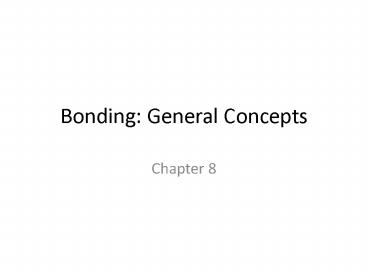Bonding: General Concepts - PowerPoint PPT Presentation
Title:
Bonding: General Concepts
Description:
Bonding: General Concepts Chapter 8 Words to know: chemical bond ionic bond covalent bond metallic bond Lewis Symbol Octet rule Practice Classify the following ... – PowerPoint PPT presentation
Number of Views:120
Avg rating:3.0/5.0
Title: Bonding: General Concepts
1
Bonding General Concepts
- Chapter 8
2
Words to know
- chemical bond
- ionic bond
- covalent bond
- metallic bond
- Lewis Symbol
- Octet rule
3
Practice
- Classify the following compounds as ionic or
covalent. Justify your answer. Which compounds
contain both types of bonds? - - KBr - SO2
- - H2SO4 - CH3COOH
- - Na3PO4 - CaCO3
4
Lewis Symbol
- Element symbol with valence electrons written
around it as dots - Elements want to gain, lose, or share electrons
to look like a noble gas (isoelectronic)
5
Place the following chemical species into
isoelectronic groups
- N3-, K, Ca2, O2-, F-, Ne, Br, Kr, Sc3, Na,
Al3, Se2-, Mg2
6
Ionic Bonding
- electrons are transferred from an atom with low
electronegativity to one with high EN - electrostatic attraction between the two
oppositely charged ions - arranged in a crystal lattice (lattice energy,
DHL, is energy required to completely separate
solid ionic compound into gaseous ions)
7
Lattice Energies?
- Lattice energy increases when the atoms are
smaller or have a higher charge (exchanging more
electrons) - higher lattice energy means the ionic compound is
more strongly bonded - high lattice energies also explains why ionic
compounds are brittle and hard
8
In each of the following pairs of compounds,
identify the one with the higher lattice energy
- KCl, CaS
- LiF, NaCl
- Fe2O3, MnO2
- CaO, CaCl2
9
Ions
- Representative elements follow the hill of
oxidation numbers when in ionic compounds - transition metals (including lead tin) are a
little weird - Their valence electrons are the highest filled s
sublevel and occasionally 1 or more of their d
electrons
10
Transition Metal Ions
- Iron
- Fe Ar 4s23d6
- Fe2 Ar 3d6
- Fe3 Ar 3d5
- Lead
- Pb Xe 6s24f145d106p2
- Pb2 Xe 6s24f145d10
- Pb4 Xe 4f145d10
11
Write the electron configurations for Cr3 and
Sn4
12
Covalent Bonding
- 2 atoms sharing electrons
- Lewis structures show shared and lone pairs of
electrons - polar or non-polar determined by difference in EN
values for the 2 bonding elements - 0-0.4 NPC
- .4-1.0 PC
- 1.0-2.0 really PC
- gt2.0 ionic
13
Dipoles
- With polar covalent bonds, there is a dipole (one
end of the bond hogs the shared electrons a
little more than the other) - symbolized with d and d- and are not whole
number charges
14
Drawing Lewis Structures
- Add up the total valence electrons of all bonding
atoms - Use one pair of electrons to bond each outer atom
to the central atom (usually the least EN or the
one present in the least abundance) - Complete octets around all of the outer atoms
- Place any remaining electrons around the central
atom - If there arent enough electrons to give the
central atom an octet, make multiple bonds
15
Practice
- Write the Lewis structures for each of the
following compounds - NO3-
- CO2
- PCl5
- NO3
16
Resonance Structures
- used when 2 Lewis structures are equally good
representations of the bonds - actual structure is kind of an average of all the
possibilities - examples include ozone nitrate ion
17
Exceptions to Octet Rule
- When there is an odd of electrons, one atom
will only have 7 electrons around it. (NO, NO2) - When the compound has a group 2 or 3 element as
the central atom, the number of electrons around
the central atom will be twice the group number - If central element is big, it can have an
expanded octet (PCl5)
18
Covalent Bond Strength
- Multiple covalent bonds are stronger than single
covalent bonds (they are also shorter) - Higher the number of electrons shared, the
stronger the bond































